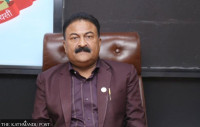National
Article 76 (5) is meant for individual lawmakers—not parties, lawyers tell bench
On the second day of hearing on House dissolution, advocates attempt to interpret the provision’s legislative intent and how it has been breached.
Tika R Pradhan
On Thursday, the second day of hearing on the dissolution of the House of Representatives, the focus was on Article 76 (5), its interpretation and the legislative intent behind incorporating the provision.
Almost all the lawyers arguing on behalf of the plaintiffs were of the view that Article 76 (5) was incorporated in the constitution with a view to giving as long a life as possible to the House, given the past experiences of frequent dissolutions whenever the prime minister wanted.
Article 76 (5) states that in cases where the prime minister appointed under clause (3) fails to obtain a vote of confidence under clause (4) and any member under clause (2) presents a ground on which he or she can obtain a vote of confidence in the House of Representatives, the President shall appoint such member as Prime Minister.
This is the fourth provision that allows the government formation after Article 76 (1), Article 76 (2) and Article 76 (3). It, however, is completely a far cry from the provisions that are in place in other countries like the United Kingdom and India where the parliamentary system is practised.
According to lawyers, Article 76 (5) allows any Member of Parliament to stake claim to the post of prime minister if he or she thinks can prove a majority.
“Actually, Article 76(5) is the most powerful weapon bestowed upon the Members of the Parliament [by the constitution],” said senior advocate Raman Kumar Shrestha while pleading on behalf of the petitioners. “This Article 76 (5) was envisioned to explore one more possibility to form a government by an individual lawmaker after the parties fail. The only intent was to make maximum efforts to save Parliament.”
Article 76 (5) comes into play when all other provisions–Articles 76 (1), (2) and (3) are exhausted, allowing an individual lawmaker to give one last try to form a government so as to save the House from untimely dissolution.
Article 76 (1) is about the leader of a party with majority in the House leading the government, while Article 76 (2) calls for formation of a government by a lawmaker who can prove a majority with the support of two or more parties. Article 76 (3) comes into play when no one can form a government under Articles 76 (1) and (2), and in such a case, a leader of the party with the highest number of members in the House can stake claim to the post of prime minister.
In principle, it may look almost impossible for an individual to secure support of a majority of lawmakers when the previous options have failed, but experts say since the provision is in the constitution, it must be followed–in letter and spirit.
Harihar Dahal, a senior advocate, said that Article 76 (5) was envisioned as a “shield” for Parliament, hinting that when it faced an imminent danger of dying, the provision could save it.
“Article 76(5) was incorporated into the constitution to save Parliament from dying an untimely death if the parties fail to form a government under various other provisions,” said Dahal.
Since Article 76 (5) provides an individual lawmaker with an opportunity to try to garner majority–from individual lawmakers regardless of which party they belong to–there are some arguments that it would risk the revival of a party-less system, like the one practiced during the Panchayat regime. And Prime Minister KP Sharma Oli and his supporters are peddling these arguments.
This argument stems from the fact that as many as 26 lawmakers of Oli’s CPN-UML party had thrown their weight behind Nepali Congress President Sher Bahadur Deuba when he approached President Bhandari to stake claim to government formation as per Article 76 (5).
On May 21, Deuba had submitted signatures of 149 lawmakers, including 26 from the UML’s Madhav Nepal faction, to the President. But the same day, Oli too staked claim to the post of prime minister saying he had the support of 153 lawmakers–121 from his UML party, including those from the Nepal faction, and 32 from the Janata Samajbadi Party. Oli, however, did not provide the lawmakers’ signatures.
It, however, had become clear on May 10 itself that the Janata Samajbadi Party was divided, with one faction led by Mahantha Thakur and Rajendra Mahato supporting Oli and the other led by Upendra Yadav and Baburam Bhattarai opposing.
After President Bhandari disqualified both the claims by Deuba and Oli, the Cabinet recommended House dissolution. President Bhandari obliged late on May 21, well past midnight, endorsing the House dissolution.
As many as 30 petitions, including one by the opposition alliance led by Deuba, were filed at the Supreme Court against the House dissolution.
The opposition alliance has demanded that the court restore the House and issue an order to appoint Deuba prime minister because he had provided the signatures of 149 lawmakers, well over the magic number of 136 required to prove a majority.
Gandhi Pandit, also a senior advocate, on Thursday argued that if Article 76 (5) is allowed to be used just by parties, it would be as good as Article 76 (2).
“Why would you need Article 76 (5) then?” said Pandit. “It is very clear that Article 76 (5) is meant for individual lawmakers.”
On Wednesday, lawyers questioned President Bhandari’s intent and her role. On Thursday, most of the ten senior advocates pleading on behalf of the plaintiffs said that Oli was not eligible to lay claim to the government on May 21 after making public a day before that the situation had not changed a bit since May 10 to secure a vote of confidence in the House.
On May 10, Oli lost a vote of confidence in the House, with just 93 lawmakers standing in his favour, as 28 lawmakers from his own party abstained. He was, however, appointed prime minister again on May 13 under Article 76 (3) after the Nepali Congress did not lay claim to the government.
Constitutionally, Oli needed to secure a vote of confidence by June 12 under Article 76 (4), but instead he prodded the President to invoke Article 76 (5).
But Oli and Bhandari worked hand in glove to dissolve the House without letting Article 76 (5) come into play.
“Oli was not eligible to make a claim to lead the government, but besides that, he did not have any authority to dissolve the House,” said Gandhi. “The Supreme Court in its earlier verdict in February has already made it clear that only a prime minister elected under Article 76 (5) can dissolve the House, should he fail to secure a vote of confidence within 30 days from the date of the appointment.”
Ten senior advocates, including Khagendra Adhikari, Borna Bahadur Karki, Hari Upreti, Mithilesh Kumar Singh, Shrihari Aryal, Prem Bahadur Khadka and Sher Bahadur KC besides Pandit, Shrestha and Dahal, pleaded on behalf of the petitioners on Thursday.
Arguments from the petitioners are expected to be completed by Friday. Lawyers on behalf of the defendants will start presenting their views from Sunday. Four lawyers from Nepal Bar Association and Supreme Court Bar Association have been invited as amicus curiae to present their briefs to the court.
Unlike in the past instance of House dissolution of December 20, when the court took two months to pass a verdict, this time, there are expectations that a verdict could come soon, as judges have set timeframes for lawyers from both sides.




 11.12°C Kathmandu
11.12°C Kathmandu













%20(1).jpg&w=300&height=200)

